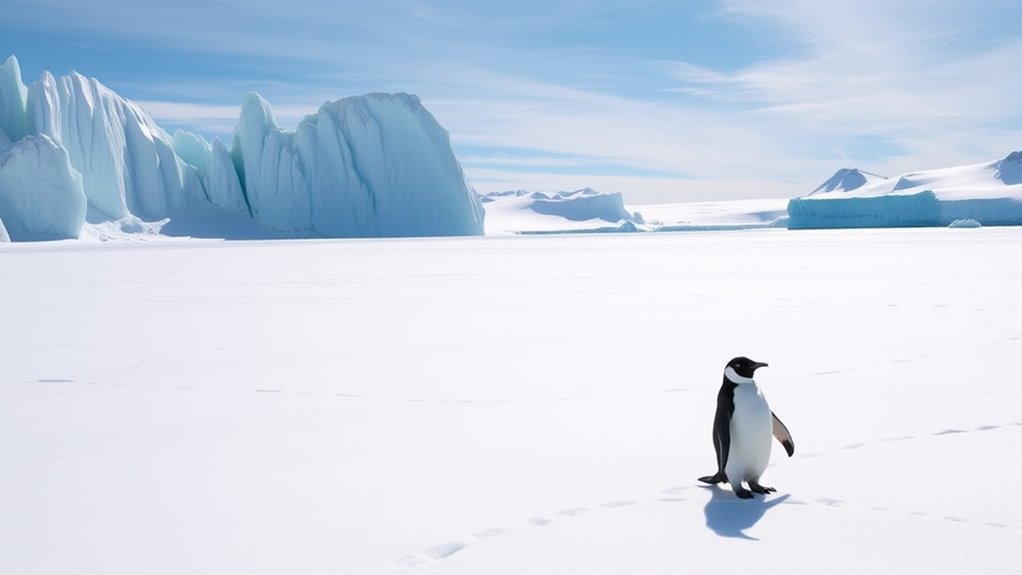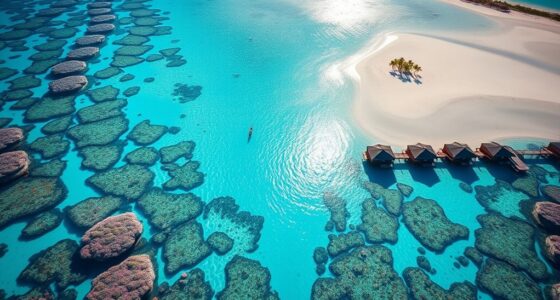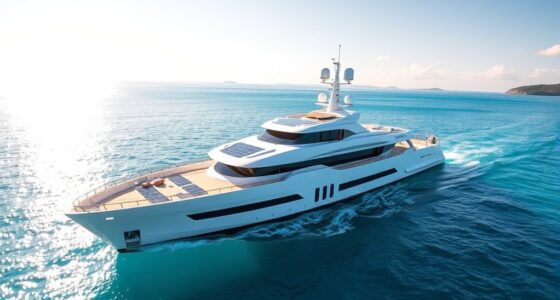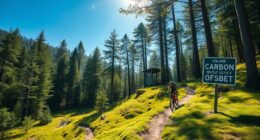Antarctica is a stunning wilderness, offering unique ecosystems and breathtaking landscapes. But it’s crucial you travel responsibly here. With fragile biodiversity and rapidly changing ice coverage due to climate change, your actions can impact this pristine environment. The Antarctic Treaty protects this region, promoting conservation and responsible tourism. By following guidelines and respecting wildlife, you contribute to preserving this extraordinary landscape for future generations. Explore how you can help safeguard Antarctica’s beauty and sustainability.
Key Takeaways
- Antarctica’s unique ecosystems and pristine wilderness are protected by the Antarctic Treaty, promoting conservation and responsible tourism practices.
- Human activities, including tourism, must be regulated to minimize environmental impact and protect native species like penguins and seals.
- Coastal areas, home to diverse species, are particularly vulnerable to climate change, highlighting the need for responsible travel to safeguard these habitats.
- Sustainable tourism initiatives educate visitors about preserving Antarctica’s wilderness while encouraging respect for its fragile environment.
- International cooperation is essential for adapting regulatory frameworks to emerging threats, ensuring the ongoing protection of Antarctica’s pristine landscapes.
The Unique Status of Antarctica’s Wilderness

Antarctica stands out as a unique wilderness, not just because it’s the coldest and most remote continent, but also due to its extraordinary environmental conditions.
With around 90% of the world’s surface freshwater locked in its massive ice sheets, some of which reach up to 4.8 kilometers thick, this continent is a crucial resource for our planet. Additionally, subglacial ecosystems thrive beneath the ice, supporting unique microorganisms that have adapted to life without sunlight for millions of years.
Approximately 90% of the world’s freshwater is stored in Antarctica’s colossal ice sheets, reaching depths of 4.8 kilometers.
You won’t find any native peoples or polar bears here, which adds to its untouched allure. Protected under the Antarctic Treaty, the continent forbids military and mining activities, ensuring its pristine state.
While human presence has increased, with over 56,000 tourists annually, much of Antarctica remains a wild haven, showcasing unique wildlife adapted to extreme conditions, making it a vital area for conservation.
Understanding Ice Coverage and Its Importance

While you might think of ice coverage as just a frozen expanse, it plays a critical role in regulating our planet’s climate and supporting diverse ecosystems.
Recent data shows Antarctic sea ice reached its lowest extent in February 2024, covering only 1.99 million square kilometers—about 30% below the 1981-2010 average. This decline began around 2016, diverging from the slightly positive trend seen from 1979 to 2015.
Rising air and ocean temperatures contribute to this worrying trend, threatening the fragile balance of life in Antarctic waters. The loss of ice habitats directly impacts species like penguins and krill, crucial for the region’s ecological stability.
Understanding these changes is vital as they affect global climate systems and environmental health.
Biodiversity in Fragile Coastal Areas

Coastal areas in Antarctica are teeming with life, making them hotspots for biodiversity. You’ll find over 8,200 species listed in the Register of Antarctic Marine Species, with many yet to be described. Most of this life thrives near the coasts, where conditions are favorable, supported by the rich ecosystems of the Southern Ocean.
Ice-free regions, though covering only 0.4% of Antarctica, are crucial for species like penguins and seals. These coastal microhabitats boast high species richness, particularly among mollusks and echinoderms.
However, they’re vulnerable to climate change and invasive species. Protecting these fragile ecosystems through expanded protected areas and responsible tourism is essential to conserve their unique biodiversity for future generations.
Human Impact on Antarctica’s Ecosystem
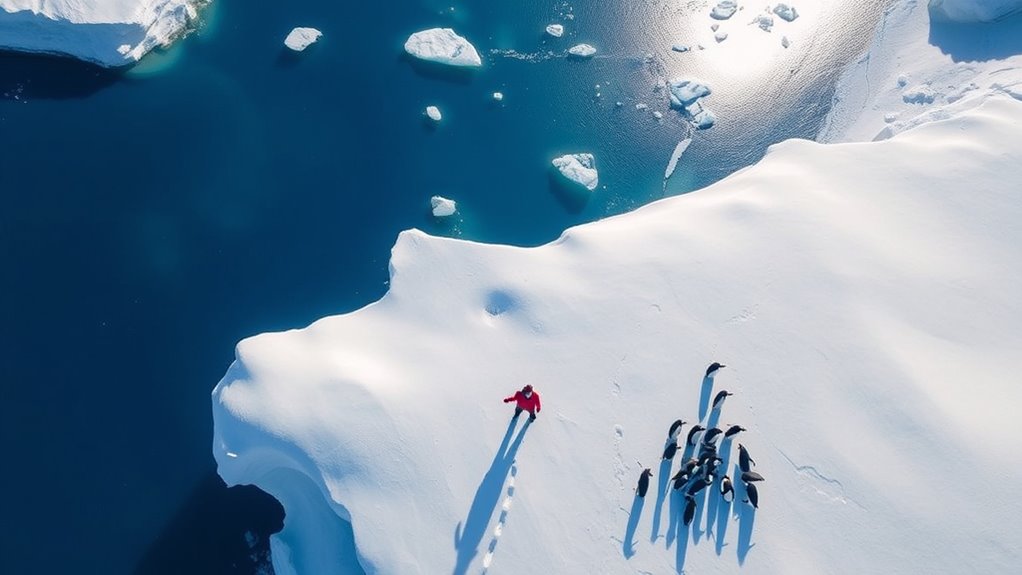
Human activities have significantly impacted Antarctica’s delicate ecosystem, leading to disturbances that threaten its unique biodiversity. Overexploitation of species like seals and penguins has caused local extinctions, while construction and transport activities disrupt flora and fauna.
The introduction of non-indigenous species, mainly on the Antarctic Peninsula, further complicates recovery efforts for overexploited stocks. Insufficient sewage disposal and chemical contamination from human presence contaminate the environment, highlighting the need for proper waste management.
Increased tourism, with over 37,800 visitors in 2008-09, raises concerns about sustainability and the risk of introducing non-native species. As you explore this pristine wilderness, remember that responsible practices are vital to protecting Antarctica’s fragile ecosystem for future generations.
The Role of the Antarctic Treaty in Conservation
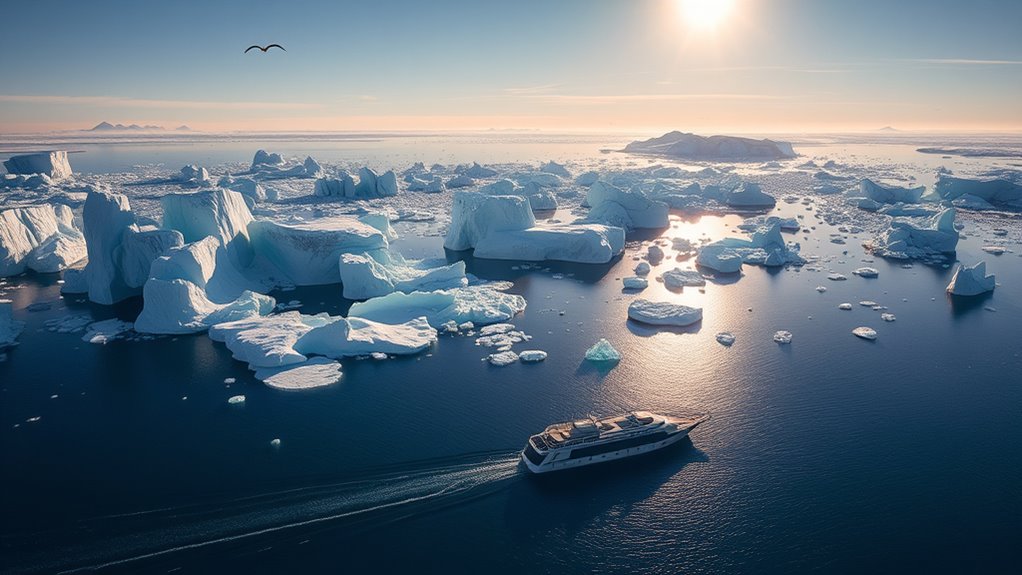
As you delve into the complexities of Antarctic conservation, it’s essential to recognize the pivotal role of the Antarctic Treaty. Signed in 1959, it was designed to foster scientific collaboration while preventing military conflict in this unique region.
The Treaty applies to all areas south of 60° South Latitude, establishing Antarctica as a zone for peaceful, scientific research. It prohibits military activities and nuclear waste disposal, emphasizing the conservation of wildlife and ecosystems.
The Madrid Protocol further strengthens these protections, designating Antarctica as a “natural reserve” and indefinitely banning mining. With tourism regulated to minimize environmental impact, the Treaty showcases successful international cooperation, ensuring that efforts to maintain this pristine wilderness continue for generations to come.
The Need for Expanding Protected Areas

While the existing network of protected areas in Antarctica provides a solid foundation for conservation, the urgent need for expansion is clear.
You’ll find that enhancing these areas not only preserves vital biodiversity but also strengthens resilience against climate change. By expanding protected regions, you can help mitigate the impact of human activities, including tourism and research, on fragile ecosystems.
Moreover, these areas offer pristine environments essential for scientific research. However, challenges like international governance and data gaps complicate expansion efforts.
Engaging in systematic conservation planning and fostering international cooperation can significantly aid in addressing these obstacles.
Ultimately, expanding protected areas reflects a shared global responsibility to safeguard Antarctica’s unique ecosystems for future generations.
Responsible Tourism Practices in Antarctica
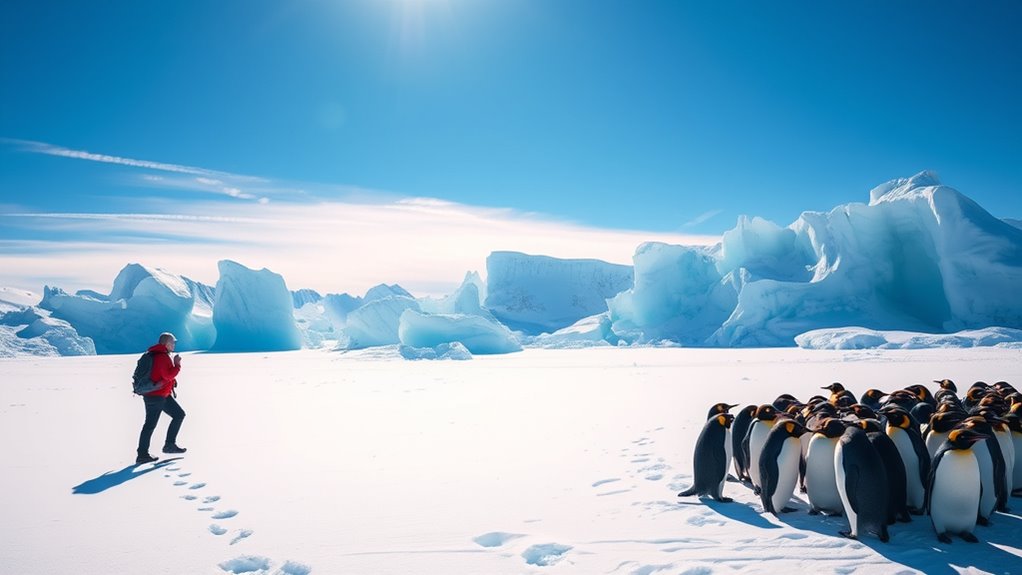
Understanding the importance of responsible tourism practices in Antarctica is crucial for preserving this unique environment. You can contribute by choosing tour operators that are members of the International Association of Antarctica Tour Operators (IAATO).
These operators follow strict environmental guidelines, including conducting assessments to minimize impact. Remember, waste management is vital—anything you bring in must be taken out.
Keep your distance from wildlife, staying at least 5 meters away to avoid disturbing them. Avoid touching or feeding animals, and steer clear of using flash photography.
Stick to designated paths to protect sensitive flora. By following these practices, you help ensure Antarctica remains a pristine wilderness for future visitors.
The Importance of Visitor Education
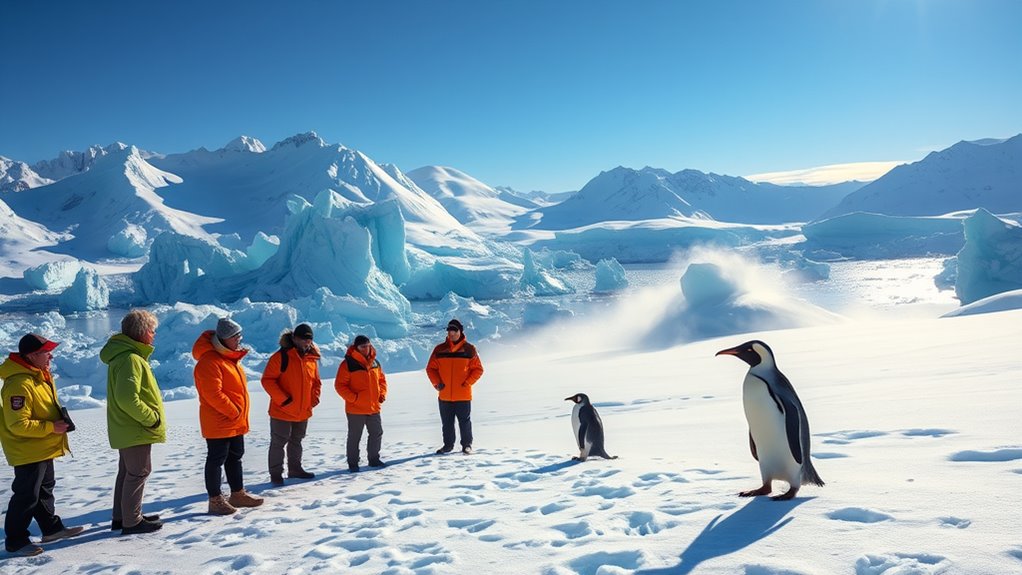
Responsible tourism practices play a vital role in preserving Antarctica’s pristine environment, but education amplifies their impact. When you visit, your primary motivations can include learning about the unique wildlife and landscapes.
Educational programs, like lectures and citizen science projects, enhance your experience and inspire you to advocate for the environment once you return home. Tailoring these educational opportunities to match your interests can boost engagement and foster a deeper connection to conservation.
Engaging in tailored educational programs fosters a deeper connection to conservation and inspires advocacy for the environment.
Organizations like IAATO help by promoting responsible practices and providing guidelines to minimize your environmental footprint. They aim to transform you into an ambassador for Antarctica’s preservation, ensuring that your adventure contributes to the long-term health of this incredible wilderness.
Your learning can lead to meaningful change.
Addressing Climate Change Threats to Antarctica

As climate change accelerates, Antarctica faces unprecedented threats that jeopardize its unique ecosystems and global climate stability. Ice melting from both above and below destabilizes glaciers, contributing to rising sea levels.
You mightn’t realize that the region warms nearly 3°C faster than the global average, impacting marine life and food webs. Krill, vital to the ecosystem, struggle to thrive as ocean conditions shift, while penguins confront habitat loss due to vanishing ice.
Regulatory frameworks like the Antarctic Treaty System are essential, yet they face challenges from competing national interests. To protect this pristine wilderness, we must advocate for strong policies, support technological advancements, and promote responsible tourism practices that minimize environmental impact.
Your actions can help safeguard Antarctica’s future.
Frequently Asked Questions
What Wildlife Species Can Be Found in Antarctica?
In Antarctica, you’ll encounter a unique array of wildlife. You can spot the largest land animal, the Antarctic midge, along with tiny springtails and resilient tardigrades.
Among the iconic penguins, you’ll find Emperor, King, and Adelie species. Humpback and Minke whales migrate to feed, while seals like the Weddell and Southern Elephant are often seen lounging on ice.
Birds such as the Wandering Albatross also grace the skies, making Antarctica truly remarkable.
How Can I Participate in Antarctic Conservation Efforts?
You can participate in Antarctic conservation efforts by supporting organizations that focus on research and protection.
Consider donating to conservation groups or participating in citizen science projects that help gather data.
When traveling, choose IAATO-registered operators to ensure responsible practices.
You can also advocate for policies that address climate change and its impact on biodiversity.
Lastly, raise awareness among your friends and family about the importance of preserving Antarctica’s unique environment.
What Are the Best Times to Visit Antarctica?
Imagine standing on a glacier as the sun sets, painting the sky in hues of orange and pink.
The best times to visit Antarctica are during its summer months, from October to March.
Early season showcases stunning ice landscapes and courtship among wildlife, while mid-season offers the warmest weather and peak activity.
Late season brings budget-friendly options and breathtaking sunsets.
Each moment immerses you in nature’s grandeur, making every visit unforgettable.
What Should I Pack for a Trip to Antarctica?
When packing for a trip to Antarctica, you’ll want to focus on layers.
Start with thermal base layers to wick moisture, then add fleece mid-layers for insulation.
Don’t forget a waterproof outer layer and insulated boots.
Bring warm gloves, a hat, and a scarf for protection against the cold.
Include essentials like a camera, binoculars, a reusable water bottle, and a first aid kit.
And always pack sunscreen and lip balm for skin protection!
Are There Any Age Restrictions for Antarctic Travelers?
Yes, there are age restrictions for Antarctic travelers.
Most tour operators set a minimum age of around 12 years, but some allow younger children, typically from age 8, if parents feel they’re mature enough.
The journey’s physically demanding, involving Zodiac excursions and uneven terrain, so you’ll need to assess your child’s readiness.
Always check with your chosen operator for their specific age policies and ensure your child can appreciate and endure the experience.
Conclusion
In your quest to explore Antarctica’s breathtaking wilderness, remember that every little bit counts. By practicing responsible tourism and supporting conservation efforts, you’re not just enjoying its beauty but also protecting it for future generations. The ice may seem eternal, but climate change is a ticking clock. So, let’s be good stewards of this pristine environment, ensuring that we leave it as we found it—untouched and magnificent. Together, we can make a difference in this fragile land.
